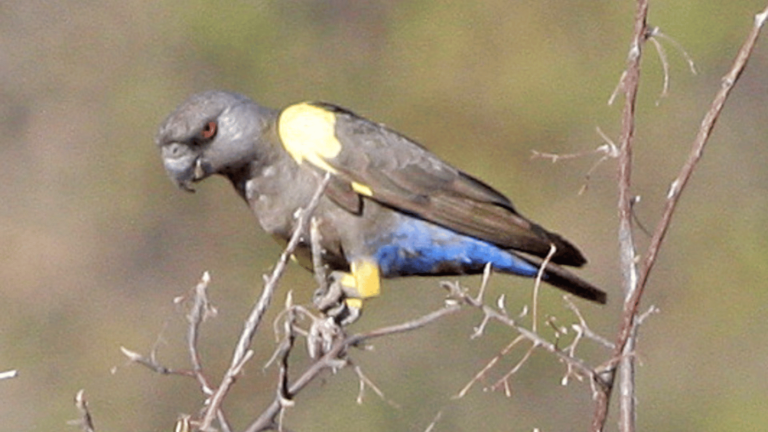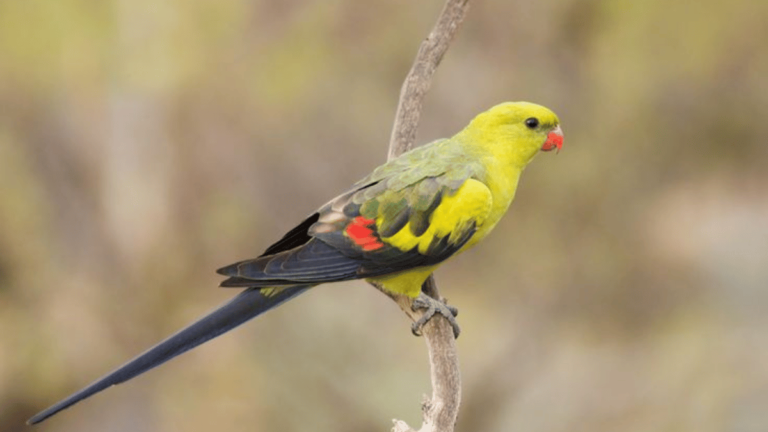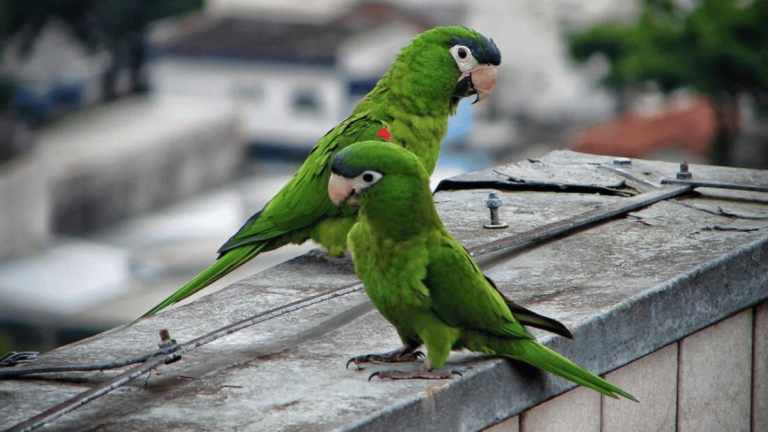Welcome to our guide on the Blue Rumped Parrot – a stunning species that will captivate you with its vibrant colors and unique characteristics. Found in the tropical regions of Southeast Asia, these parrots are a true marvel of nature. Get ready to dive into the fascinating world of these beautiful birds and learn all about their habitat, physical characteristics, behavior, conservation status, and more.
Before we begin, take a moment to admire this captivating image of a Blue Rumped Parrot:
Key Takeaways:
- The Blue Rumped Parrot is a small parrot species found in Southeast Asia.
- Males have a distinctive black mantle, red upper mandible, and blue head and rump.
- Females have a grey-brown head and green upperparts with a blue lower back.
- Blue Rumped Parrots primarily feed on seeds, fruit, and blossoms.
- Conservation efforts are needed to protect their habitats and ensure their long-term survival.
Habitat and Distribution of Blue Rumped Parrots
The Blue Rumped Parrots can be found in a variety of habitats across Southeast Asia. They are primarily found in lowland forests, typically below 700 meters in elevation. These parrots have adapted to different environments and can be found in various locations such as forests, open woodlands, orchards and plantations, mangroves, dense scrub, and coconut groves.
Their range extends across several countries including Burma, Thailand, Malaysia, Singapore, Borneo, Sumatra, and the Mentawai Islands. They are well adapted to these diverse habitats and can thrive in different ecosystems.
The Blue Rumped Parrots have two recognized subspecies: P. c. cyanurus and P. c. pontius. These subspecies have slight variations in their distribution and habitat preferences. However, both subspecies are typically found in the same general areas, with overlapping ranges across Southeast Asia.
Table: Distribution of Blue Rumped Parrots
| Country | Region | Habitat |
|---|---|---|
| Burma | Southern tip | Lowland forests |
| Thailand | Peninsular | Open woodlands |
| Malaysia | Borneo, Sumatra | Orchards and plantations |
| Singapore | N/A | Mangroves |
| Borneo | N/A | Dense scrub |
| Sumatra | N/A | Coconut groves |
| Mentawai Islands | N/A | Diverse habitats |
As seen in the table, the Blue Rumped Parrots have a wide distribution across different regions and habitats in Southeast Asia. They have managed to adapt and thrive in various ecosystems, making them a fascinating species to study and observe in the wild.
Physical Characteristics of Blue Rumped Parrots
The Blue Rumped Parrot is a visually striking bird with distinct physical features that set it apart from other parrot species. This sexually dimorphic bird showcases stark differences between males and females. The males sport a black mantle, red upper mandible, and vibrant blue head and rump. They also exhibit bright red underwing coverts and yellowish margins on the wing coverts. In contrast, the females have a grey-brown head and green upperparts, with a touch of blue on their lower back. Both sexes share a bright yellow eye, adding to their captivating appearance.
These parrots’ physical beauty is further enhanced by their small to medium size, with an average length of around 26 centimeters. They have a slender build and a graceful posture, making them agile flyers in their natural habitat. Their wingspan is approximately 18 to 20 centimeters, enabling them to navigate the dense canopy of the forests they inhabit. They possess strong beaks, which they use to crack open seeds and fruit, an essential component of their diet.
Blue Rumped Parrots’ eye-catching plumage and unique physical characteristics make them a captivating species to observe. They are truly a delight for bird enthusiasts and nature lovers alike.
| Physical Characteristics | Males | Females |
|---|---|---|
| Head and Rump Color | Blue | Grey-brown |
| Mantle Color | Black | N/A |
| Upper Mandible Color | Red | N/A |
| Underwing Coverts Color | Bright red | N/A |
| Wing Coverts Color | Yellowish margins | N/A |
| Eye Color | Yellow | Yellow |
Diet and Feeding Habits of Blue Rumped Parrots
The diet of Blue Rumped Parrots consists primarily of seeds, fruit, and blossoms. They have a diverse palate and consume a variety of seeds, including canary, oats, safflower, and hemp. In addition to seeds, they also enjoy spray millet, limited sunflower seeds, sprouted beans and pulses, boiled maize, and various fruits such as apple, pear, orange, banana, and cactus fruits. They have also been observed to consume nuts, including hazelnuts, pecans, pinenuts, and peanuts.
The feeding habits of Blue Rumped Parrots are influenced by their natural environment and available food sources. They are opportunistic feeders and will adapt their diet based on what is accessible in their habitats. They forage in the tree canopies, using their strong beaks to crack open seeds and extract the nutritious contents. They may also feed on fruits and blossoms, using their agile flight to move from tree to tree in search of food.
It is important to provide Blue Rumped Parrots in captivity with a well-balanced diet that closely resembles their natural diet. A mix of high-quality parrot seed mix, fresh fruits and vegetables, and occasional nuts can help ensure their nutritional needs are met. It is recommended to consult with avian veterinarians or avian nutritionists for specific dietary guidelines based on the age, health, and individual requirements of the parrot.
| Food | Description |
|---|---|
| Seeds | A variety of seeds such as canary, oats, safflower, and hemp |
| Spray Millet | A favorite treat for Blue Rumped Parrots |
| Fruits | Apple, pear, orange, banana, cactus fruits |
| Nuts | Hazelnuts, pecans, pinenuts, peanuts |
| Vegetables | Various fresh vegetables can be included in their diet |
“Blue Rumped Parrots have a diverse diet, enjoying a variety of seeds, fruits, and nuts. In their natural habitat, they forage in the tree canopies and adapt their feeding habits based on what is available. Providing them with a well-balanced diet in captivity is crucial for their overall health and well-being.”
Conservation Status of Blue Rumped Parrots
The Blue Rumped Parrot (Psittinus cyanurus) is currently classified as Near Threatened by the International Union for Conservation of Nature (IUCN). While it is not globally threatened at the moment, there are concerns about its population due to extensive forest destruction in the Sundaic lowlands, where these parrots reside. Of particular concern is the subspecies P. c. abbotti, which is suspected to have a population of fewer than 5,000 individuals.
To ensure the long-term survival of the Blue Rumped Parrot, conservation efforts are crucial. Protecting their natural habitats, such as lowland forests, orchards, and plantations, is vital for their continued existence. The destruction of these habitats not only affects the parrots directly but also disrupts the delicate balance of the ecosystems they inhabit.
In addition to habitat conservation, measures should be taken to address other threats to the species. These may include illegal trapping for the pet trade, hunting, and climate change. Collaborative efforts between governments, conservation organizations, and local communities are necessary to implement effective conservation strategies and ensure the protection of the Blue Rumped Parrot and its habitat.
“Conserving the Blue Rumped Parrot is not only important for the survival of this beautiful species, but it also plays a role in maintaining the overall biodiversity of the regions it inhabits. Every effort counts in preserving these birds and the ecosystems they depend on.”
To raise awareness and support for the conservation of Blue Rumped Parrots, educational programs and public campaigns can play a crucial role. By involving local communities, schools, and individuals, we can promote responsible tourism, sustainable practices, and the importance of preserving these endangered parrot species.
| Threats to Blue Rumped Parrots | Conservation Actions |
|---|---|
| Habitat destruction | Protection and restoration of lowland forests |
| Illegal trapping for the pet trade | Enforcement of laws against wildlife trafficking |
| Hunting | Community-based conservation programs to promote sustainable hunting practices |
| Climate change | Support for initiatives addressing climate change and its impact on biodiversity |
Behavior and Social Structure of Blue Rumped Parrots
Blue Rumped Parrots are highly social birds that exhibit interesting behaviors in their natural habitats. They are often seen in flocks, flying swiftly above the trees or foraging quietly in the canopy of the forest. These parrots are known for their calls, which can be described as a sharp, whistling, two- or three-note series of sounds. They also emit high-pitched peeps and song-like trilling, adding to their delightful repertoire of vocalizations. These calls serve various purposes, including communication within the flock and territorial defense.
In addition to their vocalizations, Blue Rumped Parrots are active and agile flyers. They are known for their swift and precise flight, which allows them to navigate the dense vegetation of their forest habitats with ease. These parrots possess excellent maneuverability and are often seen performing acrobatic aerial displays.
The social structure of Blue Rumped Parrots is characterized by their gregarious nature. They are frequently found in flocks of up to 20 individuals, where they engage in social activities such as feeding, grooming, and roosting together. These flocks can consist of both males and females, and they often exhibit cooperative behaviors when it comes to foraging and navigating their environment. The presence of a strong social structure plays a crucial role in the survival and well-being of these birds.
| Behavior | Description |
|---|---|
| Flight | Blue Rumped Parrots are agile flyers, known for their swift and precise flight. |
| Vocalizations | They have a range of calls, including sharp whistling sounds and high-pitched peeps. |
| Social Structure | These parrots are gregarious and often form flocks of up to 20 individuals, engaging in social activities. |
“The Blue Rumped Parrots are fascinating birds to observe in the wild. Their social behaviors and vocalizations make them a delight to bird enthusiasts. From their swift flight to their distinct calls, they truly showcase the beauty and complexity of nature.”
– Birdwatching Magazine
Breeding and Reproduction of Blue Rumped Parrots
The breeding and reproduction of Blue Rumped Parrots are fascinating processes that contribute to the survival of these vibrant birds. Breeding typically occurs during specific seasons, which can vary depending on the region. During this time, the male and female parrots engage in courtship rituals, displaying their vibrant colors and performing various behaviors to attract a mate.
Once a pair has formed, they search for a suitable tree hollow to build their nest. The female typically lays a clutch of 3-5 rounded eggs, which she then incubates for approximately 26 days. Both parents take turns incubating the eggs and caring for the young. This shared responsibility ensures the successful development and survival of the chicks.
After the incubation period, the eggs hatch, and the chicks are born. They are initially helpless and rely on their parents for feeding and protection. The parents diligently provide food, regurgitating it for the chicks to consume. As the chicks grow, their parents gradually introduce them to solid food, teaching them to forage and become independent.
| Key Points About Blue Rumped Parrot Breeding and Reproduction |
|---|
| • Breeding occurs during specific seasons, varying by region. |
| • Pairs engage in courtship rituals to attract a mate. |
| • Females lay a clutch of 3-5 rounded eggs. |
| • Incubation period lasts approximately 26 days. |
| • Both parents share incubation and care for the young. |
| • Chicks rely on their parents for feeding and protection. |
| • Parents gradually introduce solid food to the chicks. |
| • Little is known about their longevity in the wild. |
Captive Care for Blue Rumped Parrots
Proper captive care is essential to ensure the well-being and happiness of Blue Rumped Parrots. When housing these birds, it is important to provide them with ample space to move and exercise. A walk-in enclosure with a minimum length of 2.1 meters or an indoor cage with a minimum length of 1.8 meters is recommended. This allows the parrots to spread their wings and engage in natural behaviors like climbing and exploring.
The diet of Blue Rumped Parrots in captivity should consist of a variety of seeds, sprouted beans, fruits, vegetables, and complete kibble. This ensures that they receive a balanced and nutritious diet. It is important to offer a variety of food items to prevent dietary deficiencies. Fresh water should be provided daily, and the feeding dishes should be cleaned regularly to maintain hygiene.
In order to keep Blue Rumped Parrots mentally and physically stimulated, enrichment should be provided. Bird-safe branches, wooden block toys, pine cones, and leather toys can be offered to encourage natural behaviors like chewing and playing. It is also recommended to provide misters or shallow bowls of water for the parrots to bathe in, as they enjoy bathing to keep their feathers clean and healthy.
| Aspect | Recommendations |
|---|---|
| Housing | Walk-in enclosure with 2.1 meters minimum length or indoor cage with 1.8 meters minimum length |
| Diet | Variety of seeds, sprouted beans, fruits, vegetables, and complete kibble |
| Enrichment | Bird-safe branches, wooden block toys, pine cones, leather toys, misters, shallow bowls of water |
Captivity provides the opportunity to closely observe and interact with these magnificent parrots. By providing them with suitable housing, a nutritious diet, and enriching their environment, Blue Rumped Parrots can thrive in captivity and bring joy to their caretakers.
Conclusion
In conclusion, the Blue Rumped Parrot is a stunning and captivating bird found in the tropical regions of Southeast Asia. With its vibrant blue rump, red underwing coverts, and distinctive calls, it is truly a sight to behold in its natural habitat.
While the Blue Rumped Parrot is not currently considered globally threatened, it is important to prioritize conservation efforts to protect their habitats and ensure their long-term survival. With the extensive forest destruction in the Sundaic lowlands, their populations may be impacted, particularly the endangered subspecies P. c. abbotti.
In captivity, Blue Rumped Parrots require appropriate housing, a varied diet, and enrichment to thrive. Providing them with a spacious enclosure or cage, a diverse range of seeds, fruits, and vegetables, as well as engaging toys and opportunities for bathing, will help to meet their physical and mental needs.
Overall, the Blue Rumped Parrot is a remarkable species that deserves our attention and care. By taking steps to preserve their natural habitats and ensuring their well-being in captivity, we can contribute to the conservation of these vibrant and beautiful birds.
FAQ
Is the Blue Rumped Parrot an endangered species?
The Blue Rumped Parrot is classified as Near Threatened by the IUCN. While it is not currently globally threatened, extensive forest destruction in the Sundaic lowlands may have impacted its populations. The subspecies P. c. abbotti is suspected to have a population of fewer than 5,000 individuals. Conservation efforts are needed to protect their habitats and ensure their long-term survival.
What do Blue Rumped Parrots eat?
Blue Rumped Parrots primarily feed on seeds, fruit, and blossoms. Their diet includes a variety of seeds, such as canary, oats, safflower, and hemp. They also eat spray millet, limited sunflower seeds, sprouted beans and pulses, boiled maize, and a range of fruits, including apple, pear, orange, banana, and cactus fruits. They may also consume nuts, such as hazelnuts, pecans, pinenuts, and peanuts.
How do Blue Rumped Parrots behave in the wild?
Blue Rumped Parrots are gregarious birds that are often found in flocks of up to 20 individuals. They forage quietly in the canopy of the forest or fly swiftly above the trees, calling frequently. Their calls are distinctive and can be described as a sharp, whistling, two- or three-note series of sounds. They may also emit high-pitched peeps and song-like trilling. They are known to be active and agile flyers.
How long do Blue Rumped Parrots live?
Little is known about the longevity of Blue Rumped Parrots in the wild. More research is needed to determine their lifespan. In captivity, they can live for several decades with proper care and nutrition.
How should Blue Rumped Parrots be cared for in captivity?
Blue Rumped Parrots are rare in captivity but can be housed in a walk-in enclosure with a minimum length of 2.1 meters or an indoor cage with a minimum length of 1.8 meters. Their diet should include a variety of seeds, sprouted beans, fruits, vegetables, and complete kibble. Enrichment should be provided in the form of bird-safe branches, wooden block toys, pine cones, and leather toys. They also enjoy bathing, so misters or shallow bowls of water should be provided.


















